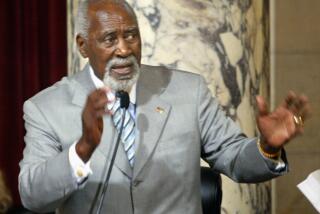Dark History Dogs Lockheed Electra Aircraft
- Share via
The Lockheed Electra that crashed near Reno Monday morning was the same plane that presidential candidate Jesse Jackson abandoned after a terrifying flight through a series of tornadoes over Texas last May.
Monday’s crash, which claimed 64 lives--including the pilot who flew Jackson for most of the two months that the candidate chartered the plane--was the latest in a series of accidents that have plagued the Electra aircraft since the model was first introduced in 1959.
Within months after the four-engine turboprop began service with several airlines, two planes crashed because the wings fell off due to engine vibration, a blow to the plane’s reputation that Lockheed was never able to overcome. Production of the aircraft was discontinued in 1961, after only 170 were built. The figure was far short of the 250 the company had projected it would need to sell in order to break even.
After the wing failures, Lockheed modified the airplanes and the Electra has enjoyed reasonable success in use all over the world. Around 100 are still in service today, and Lockheed has built more than 600 versions of a sister ship, the Orion, an anti-submarine warfare plane that uses essentially the same fuselage as the Electra.
Monday’s accident was the sixth crash of Electra passenger planes, claiming a total of 374 lives, and there have been additional crashes of Electras used as cargo planes. Five Electras have crashed since 1970, three of them in the last eight months alone.
However, James E. Burnett, chairman of the National Transportation Safety Board, said after inspecting the wreckage in Reno Monday that “there is absolutely no indication of any problem with the airplane.” Burnett, who is heading an investigation into the crash, said there “is absolutely no evidence” that the recent accidents “were due to the structural performance of the aircraft.”
The plane that crashed Monday--a 1960 model of the Electra--was also leased to Sen. John Glenn (D-Ohio) during his campaign for the presidency last February. It was owned by Galaxy Airlines of Fort Lauderdale, Fla., which has been in business only since August, 1983.
Jackson, who spoke to a Times reporter soon after learning of Monday’s tragedy, said, “I just feel numb with pain. It’s a horrible thing.”
The pilot of the aircraft, identified by Jackson as Allen Heasley, had flown Jackson often during the campaign, and three stewardesses who died in the crash had served with him during many of those flights, Jackson said. He added that he planned to spend most of the day calling survivors of the crew to express his sympathy.
Jackson stopped using the Galaxy charter after a harrowing 5 1/2-hour flight from Washington to Dallas on May 2. Jackson was accompanied by about 60 campaign aides, Secret Service agents and reporters. During the flight, the plane was buffeted by bad weather, causing some passengers to scream and sob and sending personal belongings and television equipment flying about the cabin.
“My anxiety level hit the breaking point,” Jackson said after the flight. “It was just too much for me.”
He kneeled down and kissed the ground, and then directed his aides to charter a Learjet instead.
One reporter who was aboard the flight said it often “seemed like the plane was about to break apart in the turbulence.”
After the flight, Jackson asked federal authorities to inspect the plane, and both company officials and Federal Aviation Administration inspectors said they found nothing wrong. The aircraft was returned to service soon after the incident.
Defenders of the Electra were offended by the whole affair, contending that any plane is subject to air turbulence. One letter writer told The Times that Jackson should have kissed the plane, not the ground, because it carried him through the ordeal safely.
Turbulence of one sort or another has plagued the Electra ever since Lockheed introduced it. One month after the Electra began commercial service, one of the planes crashed at LaGuardia Airport in New York, killing 65 people. Richard Stadler, a Lockheed spokesman, said that first crash, which occurred on Feb. 3, 1959, was blamed on pilot error.
It was followed by crashes on Sept. 29, 1959; March 17, 1960, and Oct. 4, 1960, that killed a total of 156 people. The first two of those crashes resulted from wing failure, apparently caused by a combination of engine vibrations and severe turbulence. The most recent crash of an Electra passenger plane was in 1968 at Dawson, Tex., where 85 people died.
Stadler said the FAA did not ground the Electra, even in the face of wing failure so early in the plane’s history, but instead imposed cruising speed limitations of 316 m.p.h. The aircraft was designed to cruise at 400. The speed limit was later reduced further to 295 m.p.h., but in 1961 the restrictions were lifted after Lockheed made extensive modifications to the fleet.
The modifications solved the technical problems, a Lockheed official said, but demand for the plane fell far short of the company’s expectations. Jetliners were introduced about the same time as the Electra, which was a propjet, and “pure jets were the rage,” the official said, adding, “People didn’t want to see propellers hanging on the wings.”
More to Read
Inside the business of entertainment
The Wide Shot brings you news, analysis and insights on everything from streaming wars to production — and what it all means for the future.
You may occasionally receive promotional content from the Los Angeles Times.










